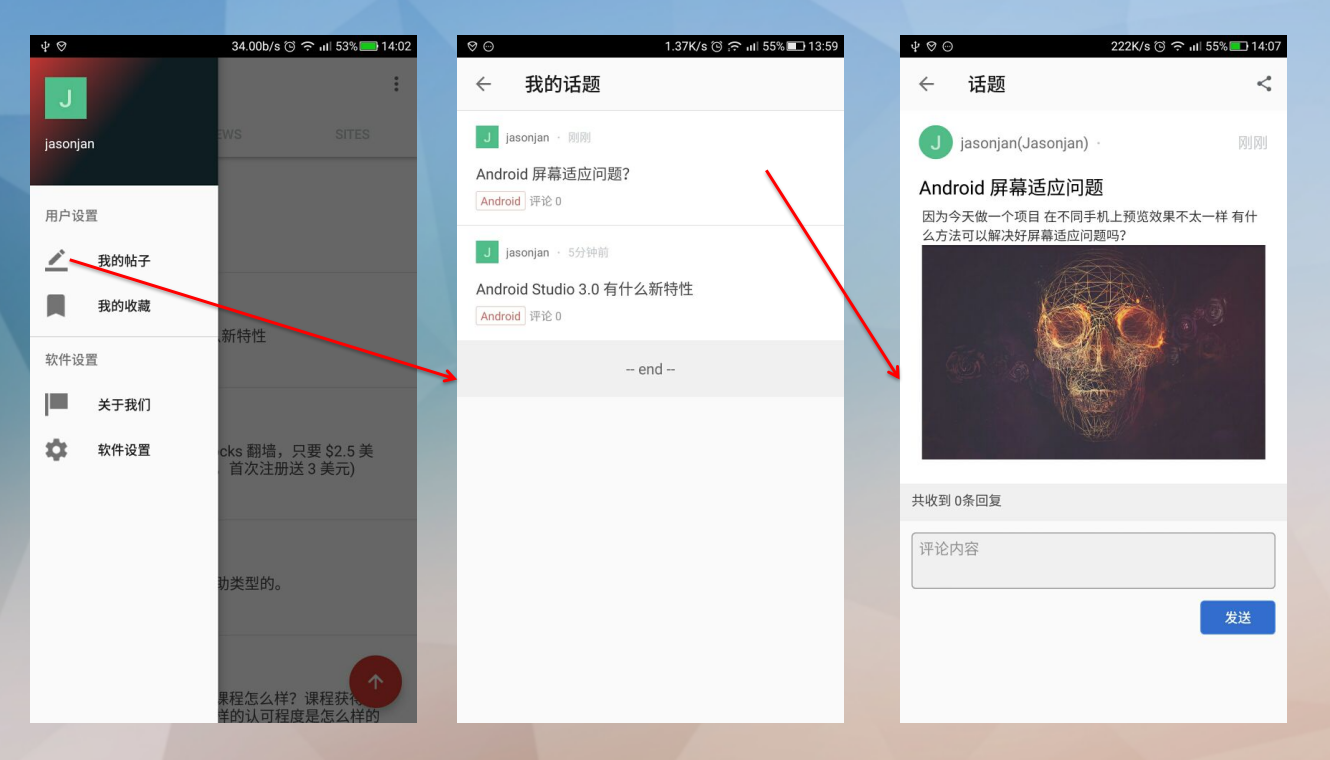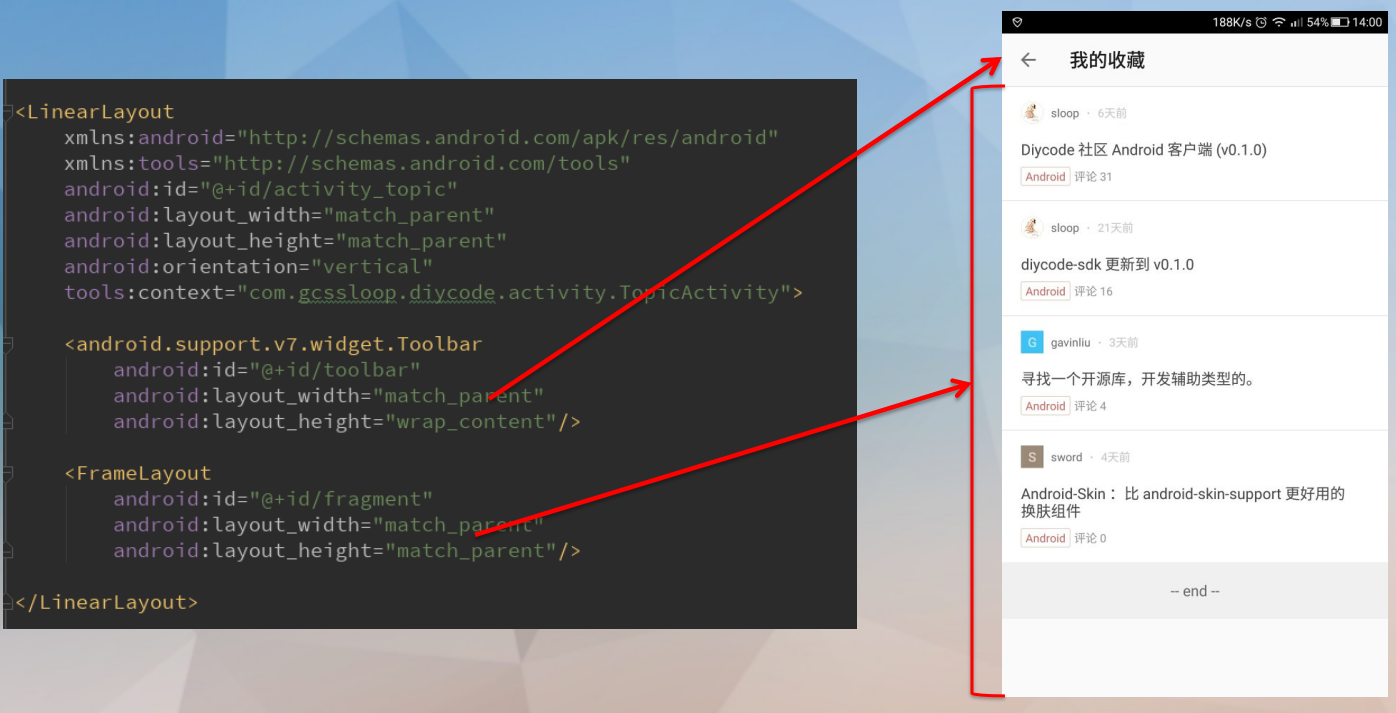Diycode开源项目 MyTopicActivity分析
1.总体浏览效果及布局分析
1.1.看一下我的帖子预览效果

1.2.然后看一下我的收藏预览效果

1.3.归纳一下
所以我的帖子和我的收藏可以共用同一个类。
布局效果几乎一样,只是用户的选择不同。
所以今天我研究的就是共用的同一个类MyTopicActivity。
1.4.中间这个活动就是MyTopicActivity。布局为:activity_fragment.
1.4.1.看一下布局的源代码。

<?xml version="1.0" encoding="utf-8"?> <!-- ~ Copyright 2017 GcsSloop ~ ~ Licensed under the Apache License, Version 2.0 (the "License"); ~ you may not use this file except in compliance with the License. ~ You may obtain a copy of the License at ~ ~ http://www.apache.org/licenses/LICENSE-2.0 ~ ~ Unless required by applicable law or agreed to in writing, software ~ distributed under the License is distributed on an "AS IS" BASIS, ~ WITHOUT WARRANTIES OR CONDITIONS OF ANY KIND, either express or implied. ~ See the License for the specific language governing permissions and ~ limitations under the License. ~ ~ Last modified 2017-04-09 19:39:57 ~ ~ GitHub: https://github.com/GcsSloop ~ Website: http://www.gcssloop.com ~ Weibo: http://weibo.com/GcsSloop --> <LinearLayout xmlns:android="http://schemas.android.com/apk/res/android" xmlns:tools="http://schemas.android.com/tools" android:id="@+id/activity_topic" android:layout_width="match_parent" android:layout_height="match_parent" android:orientation="vertical" tools:context="com.gcssloop.diycode.activity.TopicActivity"> <android.support.v7.widget.Toolbar android:id="@+id/toolbar" android:layout_width="match_parent" android:layout_height="wrap_content"/> <FrameLayout android:id="@+id/fragment" android:layout_width="match_parent" android:layout_height="match_parent"/> </LinearLayout>
1.4.2.布局对应实体关系。

1.4.3.分析整体布局
外层是一个LinearLayout线性布局。
然后是Toolbar标题栏。
然后是FrameLayout布局。
2.分析MyTopicActivity中的成员变量及部分函数
2.1.预览一下所有的变量。

这里使用了一个DataCache类,在通用类中的数据缓存工具,之前分析过。
然后使用了一个枚举类型,enum InfoType{MY_TOPIC,MY_COLLECT}
代表我的话题,我的收藏。
建立一个枚举类型的变量,初始化为我的话题。
2.2.建立一个新的实例。

在外部可以直接用MyTopicActivity.newInstance来建立一个实例,来打开这个话题列表。
2.3.获取布局资源id。
![]()
2.4.初始化数据。

在BaseActivity中执行顺序为:
getLayoutId()==>initActionBar()==>initDatas()==>initViews()
首先获取SDK中API的单例,然后建立一个缓存类。
然后获取intent中的枚举类型,如果为空就默认“我的话题”。
3.MyTopActivity关键函数initViews分析
3.1.首先看一下源代码。

@Override protected void initViews(ViewHolder holder, View root) { if (!mDiycode.isLogin()) { toastShort("用户未登录"); return; } // 获取用户名 if (mDataCache.getMe() == null) { try { UserDetail me = mDiycode.getMeNow(); mDataCache.saveMe(me); } catch (IOException e) { e.printStackTrace(); } } String username = mDataCache.getMe().getLogin(); // 初始化 Fragment FragmentManager fragmentManager = getSupportFragmentManager(); FragmentTransaction transaction = fragmentManager.beginTransaction(); if (current_type == InfoType.MY_COLLECT){ setTitle("我的收藏"); UserCollectionTopicFragment fragment1 = UserCollectionTopicFragment.newInstance(username); transaction.add(R.id.fragment, fragment1); } else if (current_type == InfoType.MY_TOPIC){ setTitle("我的话题"); UserCreateTopicFragment fragment2 = UserCreateTopicFragment.newInstance(username); transaction.add(R.id.fragment, fragment2); } transaction.commit(); }
3.2.预览一下这个函数。

3.3.第一个if
判断是否登录==>如果没有,就不存在我的话题和我的收藏了。
3.4.第二个if
判断缓存中有没有我的信息,如果没有,调用API获得并存进缓存,如果有,那继续。
3.5.然后初始化碎片。
采用方式:开启事务模式。

先从活动中得到FragmentManager,然后开启事务,动态加载碎片。
然后判断枚举类型

最后提交事务
transaction.commit()。
4.分析两个碎片
4.1.我的话题==>UserCreateTopicFragment源代码

/* * Copyright 2017 GcsSloop * * Licensed under the Apache License, Version 2.0 (the "License"); * you may not use this file except in compliance with the License. * You may obtain a copy of the License at * * http://www.apache.org/licenses/LICENSE-2.0 * * Unless required by applicable law or agreed to in writing, software * distributed under the License is distributed on an "AS IS" BASIS, * WITHOUT WARRANTIES OR CONDITIONS OF ANY KIND, either express or implied. * See the License for the specific language governing permissions and * limitations under the License. * * Last modified 2017-04-09 20:34:58 * * GitHub: https://github.com/GcsSloop * Website: http://www.gcssloop.com * Weibo: http://weibo.com/GcsSloop */ package com.gcssloop.diycode.fragment; import android.content.Context; import android.os.Bundle; import android.support.annotation.NonNull; import android.support.v7.widget.RecyclerView; import com.gcssloop.diycode.fragment.base.SimpleRefreshRecyclerFragment; import com.gcssloop.diycode.fragment.provider.TopicProvider; import com.gcssloop.diycode_sdk.api.topic.bean.Topic; import com.gcssloop.diycode_sdk.api.user.event.GetUserCreateTopicListEvent; import com.gcssloop.recyclerview.adapter.multitype.HeaderFooterAdapter; /** * 用户创建的 topic 列表 */ public class UserCreateTopicFragment extends SimpleRefreshRecyclerFragment<Topic, GetUserCreateTopicListEvent> { private static String Key_User_Login_Name = "Key_User_Login_Name"; private String loginName; public static UserCreateTopicFragment newInstance(String user_login_name) { Bundle args = new Bundle(); args.putString(Key_User_Login_Name, user_login_name); UserCreateTopicFragment fragment = new UserCreateTopicFragment(); fragment.setArguments(args); return fragment; } @Override public void initData(HeaderFooterAdapter adapter) { Bundle args = getArguments(); loginName = args.getString(Key_User_Login_Name); loadMore(); } @Override protected void setAdapterRegister(Context context, RecyclerView recyclerView, HeaderFooterAdapter adapter) { adapter.register(Topic.class, new TopicProvider(context)); } @NonNull @Override protected String request(int offset, int limit) { return mDiycode.getUserCreateTopicList(loginName, null, offset, limit); } }
4.2.分析我的话题 Fragment源代码
继承了可以刷新,加载的一个片段==>SimpleRefreshRecyclerFragment<Topic,GetUserCreateTopicListEvent>
后者GetUserCreateTopicListEvent不用管,是API中定义的一个事件。
4.2.1.分析成员变量。

主要有一个用户的登录名,用来请求服务器。
还有一个静态的字段,临时存储作用。
4.2.2.开启新的实例。

以用户名为参数,返回一个碎片。
直接新建一个类,传递了用户名的信息放入Bundle。
4.2.3.初始化数据。

采用了借刀杀人的战术,将Bundle中的数据存入本类。然后利用本类的另一个函数去请求API。
然后默认加载更多。
loadMore()定义在RefreshRecyclerFragment中,这里面去request数据。
4.2.4.设置适配器。

因为我的话题和我的收藏有可能没有,所以也包含了一个头部和尾部的适配器HeaderFooterAdapter。
采用的基类为Topic,采用的提供者为TopicProvider(context)
4.2.5.请求数据。
这个方法定义在RefreshRecyclerFragment中。

作用:实质上请求API,采用了分页效果,所以有offset和limit。
4.3.我的收藏==>UserCollectionTopicFragment源代码

/* * Copyright 2017 GcsSloop * * Licensed under the Apache License, Version 2.0 (the "License"); * you may not use this file except in compliance with the License. * You may obtain a copy of the License at * * http://www.apache.org/licenses/LICENSE-2.0 * * Unless required by applicable law or agreed to in writing, software * distributed under the License is distributed on an "AS IS" BASIS, * WITHOUT WARRANTIES OR CONDITIONS OF ANY KIND, either express or implied. * See the License for the specific language governing permissions and * limitations under the License. * * Last modified 2017-04-09 20:45:09 * * GitHub: https://github.com/GcsSloop * Website: http://www.gcssloop.com * Weibo: http://weibo.com/GcsSloop */ package com.gcssloop.diycode.fragment; import android.content.Context; import android.os.Bundle; import android.support.annotation.NonNull; import android.support.v7.widget.RecyclerView; import com.gcssloop.diycode.fragment.base.SimpleRefreshRecyclerFragment; import com.gcssloop.diycode.fragment.provider.TopicProvider; import com.gcssloop.diycode_sdk.api.topic.bean.Topic; import com.gcssloop.diycode_sdk.api.user.event.GetUserCollectionTopicListEvent; import com.gcssloop.recyclerview.adapter.multitype.HeaderFooterAdapter; /** * 用户收藏的 topic 列表 */ public class UserCollectionTopicFragment extends SimpleRefreshRecyclerFragment<Topic, GetUserCollectionTopicListEvent> { private static String Key_User_Login_Name = "Key_User_Login_Name"; private String loginName; public static UserCollectionTopicFragment newInstance(String user_login_name) { Bundle args = new Bundle(); args.putString(Key_User_Login_Name, user_login_name); UserCollectionTopicFragment fragment = new UserCollectionTopicFragment(); fragment.setArguments(args); return fragment; } @Override public void initData(HeaderFooterAdapter adapter) { Bundle args = getArguments(); loginName = args.getString(Key_User_Login_Name); loadMore(); } @Override protected void setAdapterRegister(Context context, RecyclerView recyclerView, HeaderFooterAdapter adapter) { adapter.register(Topic.class, new TopicProvider(context)); } @NonNull @Override protected String request(int offset, int limit) { return mDiycode.getUserCollectionTopicList(loginName, offset, limit); } }
4.4.分析我的收藏 Fragment源代码。
继承了可以刷新,加载的一个片段==>SimpleRefreshRecyclerFragment<Topic,GetUserCollectionTopicListEvent>
后者GetUserCollectionTopicListEvent不用管,是API中定义的一个事件。
4.4.1.分析成员变量。

主要有一个用户的登录名,用来请求服务器。
还有一个静态的字段,临时存储作用。
4.4.2.开启新的实例。

以用户名为参数,返回一个碎片。
直接新建一个类,传递了用户名的信息放入Bundle。
4.4.3.初始化数据。

采用了借刀杀人的战术,将Bundle中的数据存入本类。然后利用本类的另一个函数去请求API。
然后默认加载更多。
loadMore()定义在RefreshRecyclerFragment中,这里面去request数据。
4.4.4.设置适配器。

因为我的话题和我的收藏有可能没有,所以也包含了一个头部和尾部的适配器HeaderFooterAdapter。
采用的基类为Topic,采用的提供者为TopicProvider(context)
4.4.5.请求数据。
这个方法定义在RefreshRecyclerFragment中。

作用:实质上请求API,采用了分页效果,所以有offset和limit。
5.总结一下
5.1.理解了把我的话题和我的收藏放在一起,因为收藏的只能是话题,所以我的话题和我的收藏都是同一个活动。
如何区分的?由碎片+枚举来完成。枚举是为了区分intent中获得type是话题还是收藏,然后选择不同的碎片。
5.2.理解了为什么很多活动都有一个newInstance的静态函数,用了打开本身。比如一个其他活动的按钮,点击后,
直接跳转到这个活动,直接调用这个活动的newInstance函数岂不是很方便,耦合性也低,nice啊。
5.3.理解了为什么要把initDatas函数放在initViews之前执行,因为要获取缓存数据,以及如何请求的问题,数据
互相之间是有关联的,从一个数据到另一个数据,必然存在一个纽带,首先要从initDatas找到这个纽带,然后
去API中请求数据,得到数据之后,将数据完美显示在视图中又是另外一个过程。
5.4.理解了碎片的加载过程,首先要从活动中getSupportFragmentManager(),然后开启一个事务,然后transaction
来动态添加这个碎片类到一个布局中,这个布局应该是主活动的一个FrameLayout视图,这里的意义就是当前
共用活动中的FrameLayout布局的id,最后transaction.commit()一下就好了。
5.5.一个注意点,缓存问题,首先一定要从我的缓存类中获取一下,如果获取不到,再去请求API,这样才能显示缓
存的意义。同时,如果之前没有缓存,那么API请求到数据后,一定要加入缓存。




